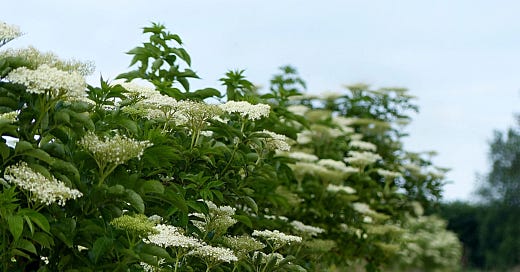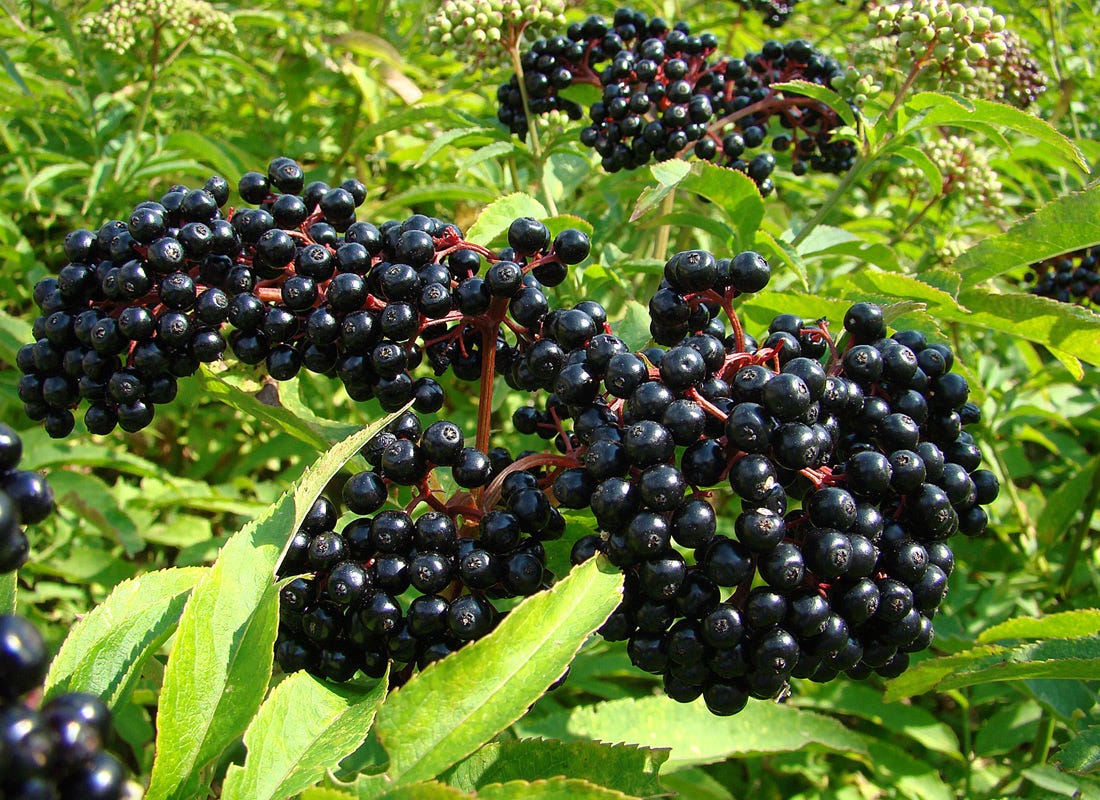Rediscovering the American Elderberry: A Journey Through History, Culture, and Cultivation
The berry that fed the world
Elderberry is a woody perennial native to both North America (Sambucus canadensis) and Europe (Sambucus nigra) as two separate species. Both have been used for similar purposes across the globe, but looking at historical evidence, more has been written about the European elderberry than the American. That said, the American offers unique properties worth exploring and elevating here in North America, where it has thrived as a landscape plant despite invasive species pressure.
American elderberry seeds have been documented as far back as 16,000 years ago, fossilized in Appalachia alongside maple, St. John’s Wart, bogbean, and birch.1 Its ubiquity seems to be linked to its cold resistance during the Younger Dryas, during which it spread across the continent. American elderberry has been documented growing in regions as cold as zone 2, while also thriving in places such as modern Florida— zone 10.
The elderberry has been prized as a food and medicine across the planet— it’s rich in vitamins A & C, phosphorous, potassium, and iron, as well as showing antiviral properties, specifically when it comes to respiratory issues.2 In Europe, the written history of the elderberry is long and complex, from Hippocrates describing the plant as his “medicine chest” in 400 BC for its wide applications to books written today continuing to advocate for further research of the plant’s potential. However, when writing about the ‘elder tree’, the leaves more often than any other part of the plant were used.
While academic research has focused on the fruit of the European elderberry, Health Canada, the agency responsible for regulating medical claims on dietary supplements in the nation, uses both species interchangeably for medical purposes.3 COVID-19, in particular, brought to light its health benefits around respiratory health after shortages of the antiviral drug Tamiflu.4 Today, research is unlocking the truth regarding elderberry’s potential for reducing the length and severity of colds and flu, although more is still to be done.5
Now, unlike the tree-like European elderberry, the American is bushier, with shallow, mat-like roots, and can survive in regions with consistently wet soils, while also thriving in well-drained soils. Unlike the European elderberry, the American is much less commonly sold to the general public, despite having better cold hardiness. The primary benefit of the European is more pronounced flavor and aroma, as well as sweeter, bigger berries.6
In North America, the plant was used and revered across the entire continent. The elderberry was present at the beginning of history, according to the Hool-poom'-ne, an Indigenous tribe that lived on the east side of the lower Sacramento River, beginning a few miles below the place where the city of Sacramento now stands.7 The Iroquois told stories where the elderberry bush was associated with trustworthiness and honesty.8
For the Northern Foothill Yokuts, the elderberry harvest in August also announced sugar pine nut harvest and the Coastal Pomo tracked shellfish gathering by the flowering and ripening of the elderberry.9, 10 The plants were managed with controlled burns, which reduced can removal management, and pest pressure, and kept a clear canopy to maximize fruit production. The fruits were also used for dye, the flowers for treating fevers, and the berries were processed by drying on mats in the sun to store for consumption through the winter, which were then cooked into a sauce.11 The young leaves were also used to make an “eye-water”.12 In many ways, the use of the elder was very similar across the globe.13
Archaeobotanical results from former Patwin sites confirm the primary role that elderberries played in many communities— and that “small edible seeds, elderberries, and acorn nutshell comprise the bulk of the archaeobotanical assemblage.” As we’ve covered with regards to acorns, they were, for many communities, the most important wild food for survival, and elderberries showed similar amounts of archaeological remains. While not a direct correlation, it highlights the incredible importance the elderberry played in the survival of communities.14 These seeds were also charred, again, highlighting the processing that went into the fruit for long-term storage.
The fruit of the European elderberry is rarely consumed raw— the seeds, like many fruits, contain cyanide-inducing glycoside. However, the University of Missouri found that ripe American elderberry cultivars’ berries and seeds contained little to no glycosides, unlike European varieties.15 That said, I wouldn’t suggest eating them, as crosses can be common and that’s only one study. Traditionally, cooking the berries over 180 degrees F or through fermentation breaks down and deactivates the glycosides, making the fruit edible.
In recent memory, one of the most significant breeders for Elderberry was Lewis Hill, a Vermont horticulturalist responsible for not only two American elderberry cultivars— Coomer and Berry Hill— but also for two black currant cultivars and nine registered daylilies.
Despite its limited exposure to commercial production, many American cultivars exist, many of which were developed in the northeastern part of the continent.
In Missouri, several cultivars have been developed as well, including ‘Bob Gordon’, a relatively new cultivar that offers several benefits— large berries, large yields, and clusters that hang upside down, which protects berries somewhat from birds.
Other cultivars and selections include the following:
Eridu (Missouri), Ranch (Missouri), Wyldewood 1 (Missouri— has the potential to produce 12,000 lbs per acre), and Wyldewood 2 (Missouri— primarily for flower production). Missouri’s research program has been one of the leaders in American elderberry breeding work and is still trying to bring new genotypes to market.16 A wild selection called ‘Pocahontas’ was found and tested at two locations from 2015 to 2021, which out-yielded ‘Bob Gordon’ and was similar to ‘Wyldewood 1’.17
Typically, elderberry bushes will send up new canes or primary branches each year. It typically takes five years or more for bushes to reach full height. The best yield is usually on the second-year canes with lateral branches. However, as the number of lateral branches with clusters increases, the size of the cluster will shrink if the bushes are not pruned. New plants don’t need pruning, and only after the second season should plants be pruned, during late winter. Canes three years or older should be removed, and the plants should be pruned down to no more than ten canes.18
One of the challenges of elderberry harvesting is that the newer canes tend to produce fruit earlier than the older canes, meaning harvesting can take several trips. Further, the berries begin to deteriorate quickly after harvesting— in as short as 2 to 4 hours, and only last a few days in refrigeration before needing further processing.
Growers today estimate that you can hand harvest roughly 22 pounds an hour. To process, the fastest and easiest method is to screen. This means to use some hardware cloth and gently rub the stems of the berries across teh screen, causing the ripe berries to loosen up fairly easily. Processing 20 pounds might take fifteen minutes. At 340 calories a pound, this equates to roughly 6000 calories an hour, meaning an hour could provide a large family with a meaningful amount of fruit (for caloric purposes) for the day. While fruit calories are much easier to harvest and process than protein-rich calories like acorns or hickories, for such a small-sized fruit, compared to others of a similar size, is quite significant.
If you’re looking to propagate elderberry, they’re quite easy to do. Take hardwood cuttings during the winter of over a foot and sticking all but a few inches into the soil with heavy watering should give you a few new plants for only a little work. It’s important to keep the cuttings in cool, shady, moist conditions until they’re ready to be rooted, and when they’re put in soil, do the same. You can also take root cuttings as well. As larger plants grow, they’ll send out runners, which can be cut off and replanted.
If you’ve enjoyed this piece, which is equal to a 7-page chapter, of (so far) a 1320-page book with 998 sources, you can support our work in several ways. The first is by sharing this article with folks you think would find it interesting. Second, you can listen to the audio version of this article in episode #240 of the Poor Proles Almanac wherever you get your podcasts. If you’d like to financially support the project, and get exclusive access to our limited paywalled content, you can become a paid subscriber on Substack or Patreon, which will both give you access to the paywalled content and in the case of Patreon, early access to the audio episodes as well.
Kneller, M.; Peteet, D. Late-Glacial to Early Holocene Climate Changes from a Central Appalachian Pollen and Macrofossil Record: Quarternary Research. 51: 133-147 p. 1999.
Zakay-Rones, Z., Varsano, N., Zlotnik, M., Manor, O., Regev, L., Schlesinger, M., & Mumcuoglu, M. (1995). Inhibition of Several Strains of Influenza Virus in Vitro and Reduction of Symptoms by an Elderberry Extract (Sambucus nigra L.) during an Outbreak of Influenza B Panama. The Journal of Alternative and Complementary Medicine, 1(4), 361–369. https://doi. org/10.1089/acm.1995.1.361
https://www.rosaliewilson.com/wp-content/uploads/2017/01/ElderberryGuideComplete.pdf
https://www.latimes.com/local/california/la-me-ln-flu-surge-20180106-htmlstory.html
Wieland, L.S., Piechotta, V., Feinberg, T. et al. Elderberry for prevention and treatment of viral respiratory illnesses: a systematic review. BMC Complement Med Ther 21, 112 (2021). https://doi.org/10.1186/s12906-021-03283-5
Charlebois, D.; P. L. Byers; C. E. Finn, and A. L. Thomas. Elderberry: Botany, Horticulture, Potential. Horticultural Reviews: Wiley-Blackwell. 37: 213-280 p. 2010.
C. Hart Merriam. The Dawn of the World, http://www.sacred-texts.com/nam/ca/dow/dow14.htm
J.N.B. Hewitt. A Constitutional League of Peace in the Stone Age of America: The League of the Iroquois and Its Constitution, 1920, p. 539
Anderson, K. (2013). Tending the wild: Native American knowledge and the management of California's natural resources. Berkeley, California, University of California Press.
Lightfoot, Kent, and Parrish, Otis. California Indians and Their Environment: An Introduction. Ukraine, University of California Press, 2009.
https://ucanr.edu/sites/Elderberry/Indigenous/Indigenous_perspectives/
Edward Hamilton. The Flora Homoeopathica: Or Illustrations & Descriptions of the Medicinal Plants Used in Homoeopathic Remedies, 1852, p. 455
The Herb Society of America’s Essential Guide to Elderberry. http://www.herbsociety.org/file_download/inline/a54e481a-e368-4414-af68-2e3d42bc0bec
Charles H. Miksicek “On The Cusp of History: Archaeobotanical Remains from CA-YOL-182”, BioSystems Analysis, Inc., Santa Cruz.
Moody, John. The Elderberry Book: Forage, Cultivate, Prepare, Preserve. Canada, New Society Publishers, 2019.
https://www.actahort.org/books/1061/1061_26.htm
https://www.actahort.org/books/1381/1381_8.htm
Cornell University, D. O. H. Minor Fruits, Elderberries, Sambucus spp. Cornell University: Cornell University 2015.







